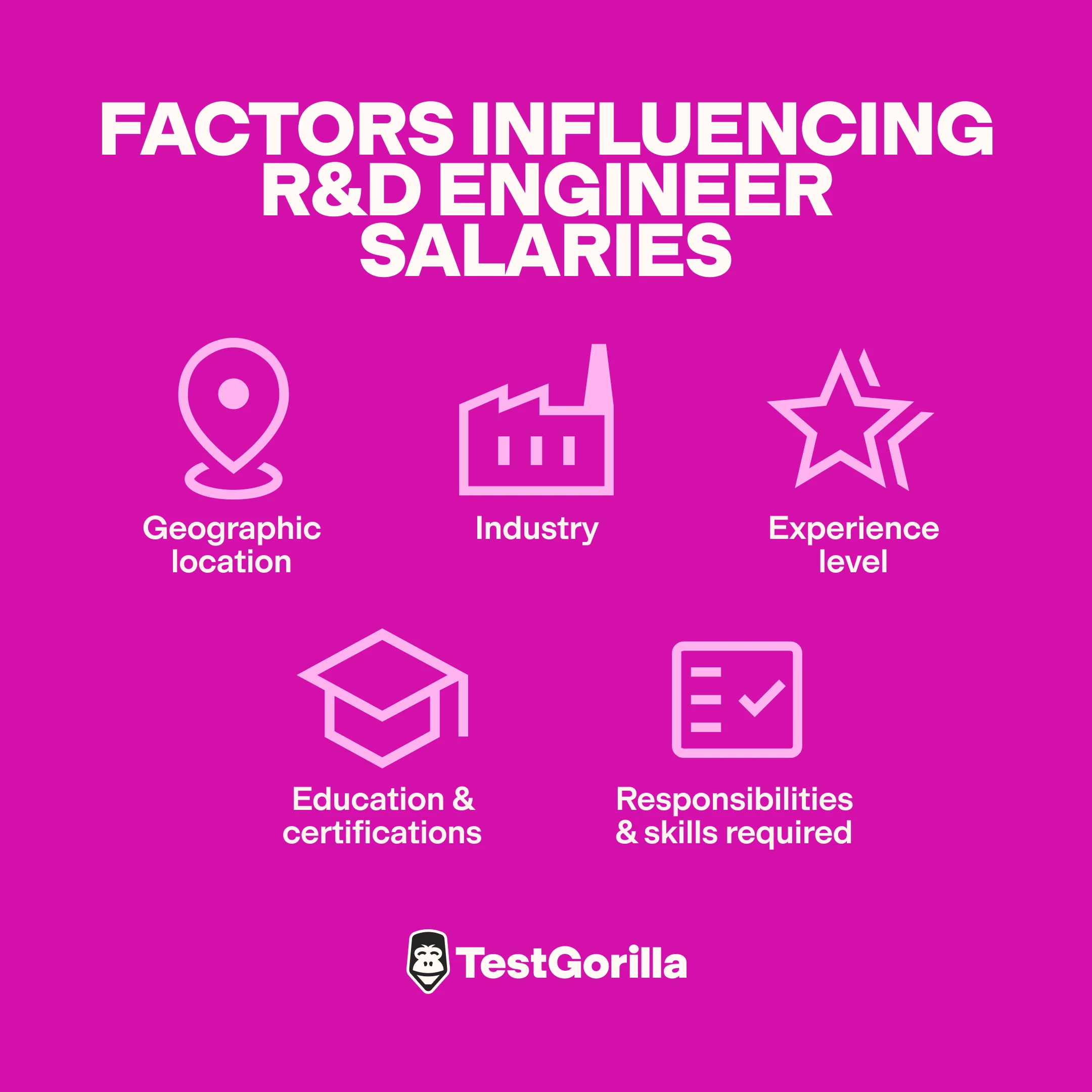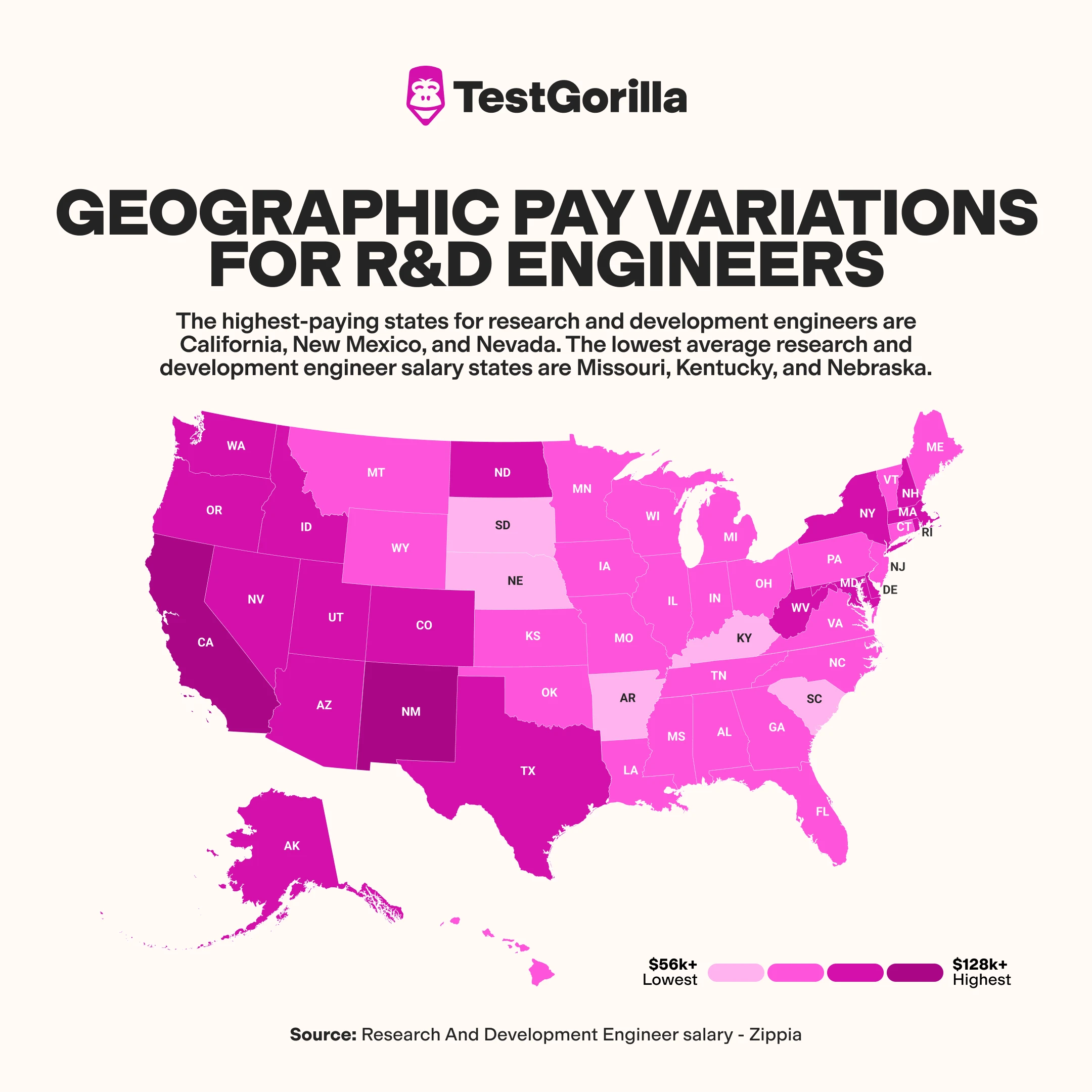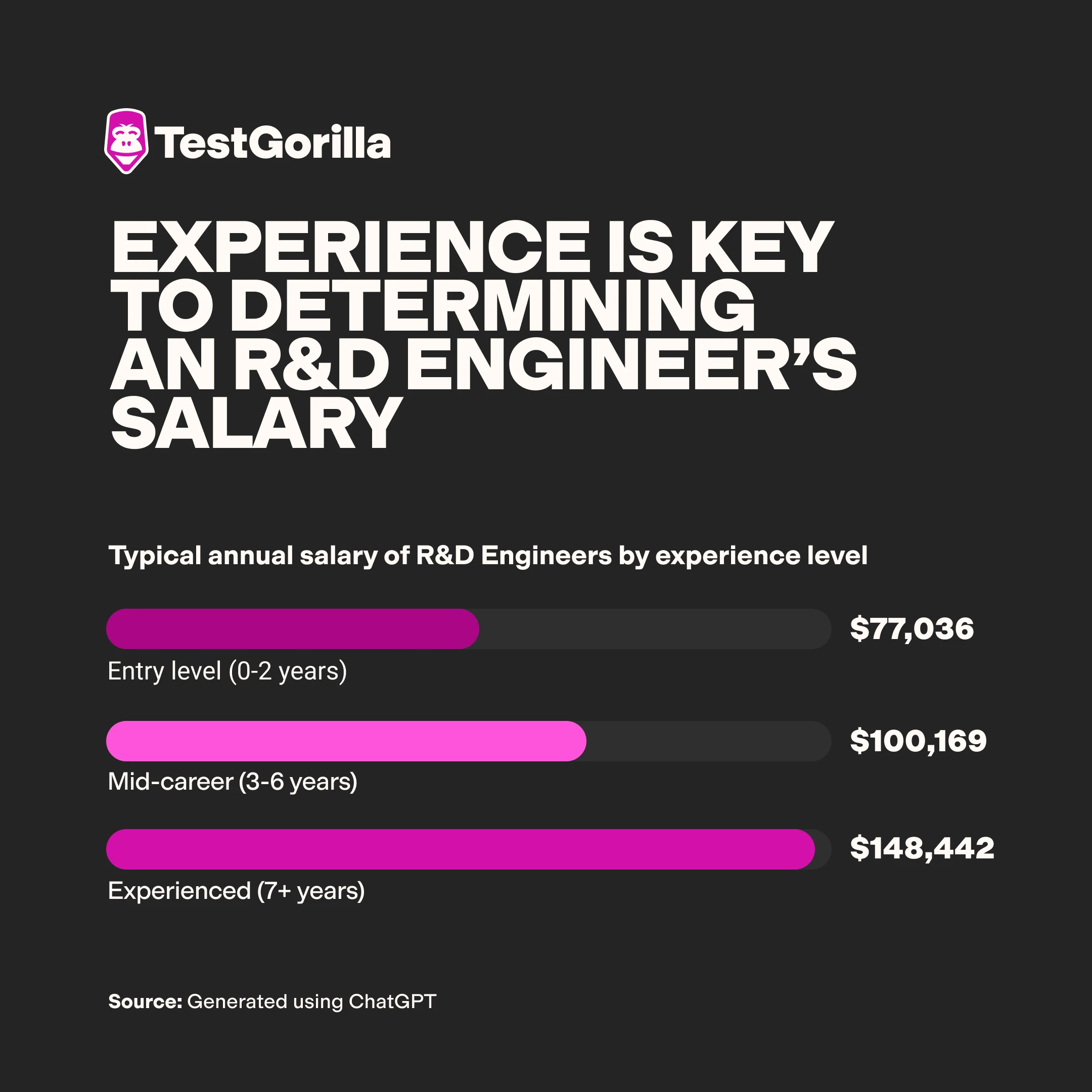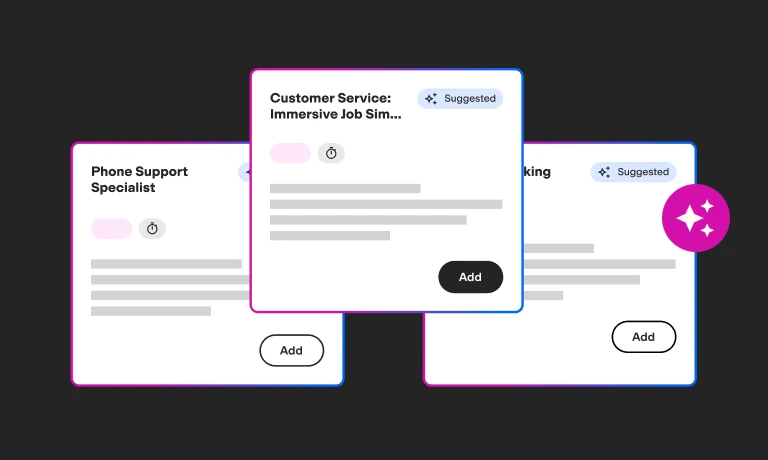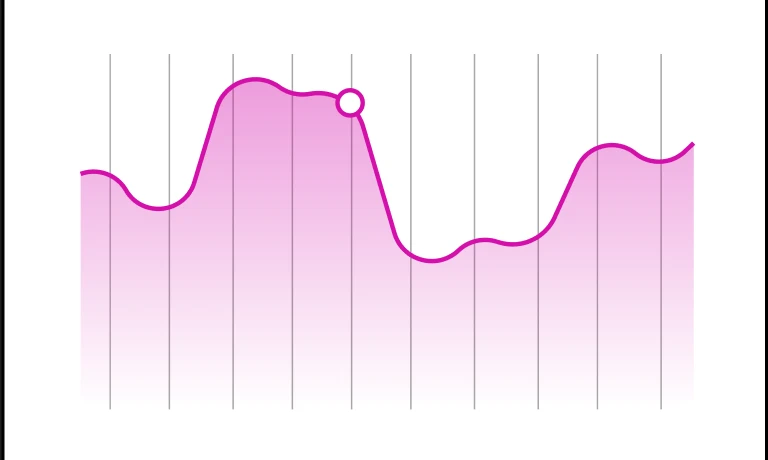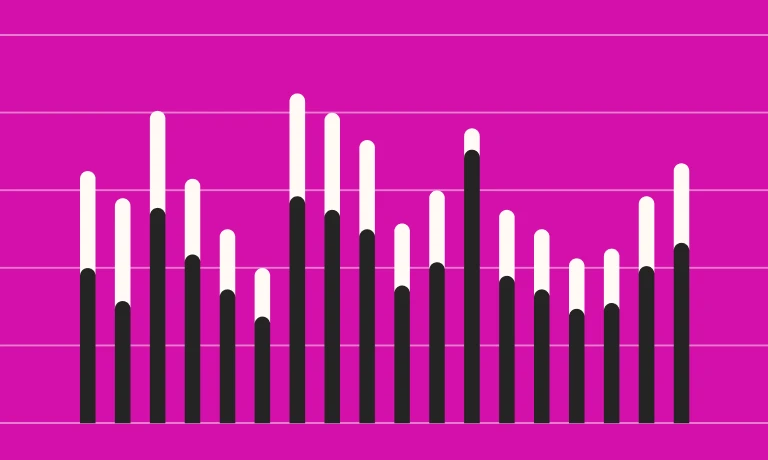It’s easy to understand the crucial role research and development (R&D) engineers play in a company’s success, but deciding what pay to include in your R&D engineer job description isn’t as clear.
R&D engineers across the US earn vastly different amounts. What they earn comes down to where they work, which company they work for, and where they're at in their careers.
We’ve delved into the latest 2024 data on US-based R&D engineer pay to help you set a competitive salary that’s aligned with market standards – so you can attract and retain your R&D talent.
How we researched this topic
We wrote this article primarily using data from Zippia, a career resource website with its own job board. Much of Zippia’s salary data comes from its own resume and job data, which provides us with a reliable, realistic, and up-to-date picture of salary trends nationwide.
While the US Bureau of Labor Statistics (BLS) is our usual source for salary data, this organization includes R&D engineer roles within broader occupational groups rather than as a standalone category. This means we can’t use this data to understand salary trends for this role specifically.
Key takeaways
The typical R&D engineer in the US earns $100,169 per year. Entry-level positions usually pay between $74,000 and $88,467, while the top earners earn $135,000+.
To get an understanding of typical salaries, look at the median salary. The mean salary is the average – and a few exceptionally high earners can bump up the average.
There’s tons of variation between R&D engineer salaries. What an individual R&D engineer earns depends on their experience, geographic location, the industry they work within, and the skills they’ve developed.
An R&D engineer's salary is only one part of their overall compensation. Benefits like paid time off, health care, and retirement plans increase the value of compensation packages and may help offset lower-than-average salaries.
The best insights on HR and recruitment, delivered to your inbox.
Biweekly updates. No spam. Unsubscribe any time.
National salary statistics for R&D engineers
Here are some national salary stats for this role:
Pay metric | Annual salary ($) | Hourly wage ($) |
Median | $100,169 | $48.16 |
Top 10% earners | $135,000 | $64.90 |
Bottom 10% earners | $74,000 | $35.58 |
Median salary vs. mean salary
R&D engineer salary data often come in two figures: the median and the mean. Each offers a unique insight into pay trends:
Median salary: This is the middle value in the range of R&D engineer salaries in the US. It provides a solid picture of a typical wage because 50% of R&D engineers earn below this amount, while half earn above it.
Mean salary: This is calculated by adding up all R&D engineer salaries in the US and dividing the result by the number of individuals holding the role. Remember that a few outliers with exceptionally high earnings can skew this average upward, making it higher than what most R&D engineers actually earn.
Generally, median figures are better representations of typical pay since they aren’t distorted by outliers.
Factors influencing salaries
Several factors can influence what you pay an R&D engineer:
Geographic location: Due to cost of living and local demand, the pay for R&D engineers varies greatly from state to state and city to city. For example, the median salary for R&D engineers in Dallas, Texas is $120,187, whereas over in El Paso, Texas, it’s just $106,062.
Industry: The industry an R&D engineer works in plays a significant role in determining their salary. Fields that rely heavily on new technologies, such as automotive and medical industries, have large research and development budgets and offer higher salaries to attract top talent.
Experience level: Salaries generally follow an upward trajectory as R&D engineers gain experience. Those with years of experience have developed the expertise needed to command the highest salaries.
Education and certifications: Completing advanced education beyond a bachelor’s and achieving professional certifications can increase R&D engineers’ earning potential – especially if they have the skills to back up these credentials.
Responsibilities and skills required: R&D engineers who take on additional responsibilities or work within specialized areas usually often see higher earnings. For example, industries related to national security, pharmaceuticals, and high-tech sectors are among some of the highest-paying employers due to the importance and complexity of their work.
Geographic pay variations
There are large variations in R&D engineer salaries across the US, with salaries as low as $56,000 per year in some areas – to salaries exceeding $128,000 in the highest-paying states.
The highest-paying states for R&D engineers are marked in the darkest color on this map. The top five of these are:
California
Washington
New Mexico
Nevada
Oregon
The lowest-paying areas are the lightest colored on the map. The five lowest-paying states for US-based R&D engineers are:
South Carolina
Arkansas
Kentucky
Mississippi
South Dakota
Cost of living is a significant factor for the variation in R&D engineer salaries across the US. For example, R&D engineers in California earn around $124,903 – much more than the $76,771 per year those in Alabama get. But when you consider that the average cost of living for a single person in Alabama was $44,529 per year in 2023, compared with $64,835 for someone in California, you can see how cost of living impacts pay.
Industry-specific pay data
Here’s a look at the four industries that pay R&D engineers the most, as per Zippia:
Highest-paying industries | Average annual salary |
Technology | $107,654 |
Automotive | $98,512 |
Manufacturing | $95,786 |
Healthcare | $89,895 |
The lowest-paying R&D engineer salaries are usually found in industries with smaller overall budgets for research and development. These tend to be smaller and less technology-driven industries, such as education and nonprofits.
Please note that other sources provide different insights into industry-specific data. For instance, according to Glassdoor, the industry where R&D engineers earn the most is aerospace and defense. Looking at multiple sources can give you a more holistic overview of pay data.
Pay by experience and education
R&D engineer salaries vary a lot based on individuals’ qualifications and experience. Here’s what these engineers earn on average at different stages throughout their careers:
Entry-level (0-2 years): $77,036/year or $37.04/hour
Mid-career (3-6 years): $100,169/year or $48.16/hour
Experienced (7+ years): $148,442/year or $71.36/hour
Certifications and education that can lead to higher pay
The minimum educational requirement for most R&D engineer roles is a bachelor’s degree. This typically must be in a field that’s relevant to the industry and specific work the engineer will be doing.
R&D engineers with higher levels of education – such as a master’s – and professional certifications often secure higher-paying roles.
Key R&D engineer certifications include:
Engineer In Training (EIT): This certification from the National Council of Examiners for Engineering and Surveying (NCEES) is awarded on completion of the EIT Exam – the first of the two fundamental exams to obtain the Professional Engineering License (PE).
Certified Chemical Engineer (CCE): This certification is for R&D engineers in chemical engineering to validate their professional experience after at least two years on the job.
Software Engineering Master Certification (SEMC): This certification from the Institute of Electrical and Electronics Engineers (IEEE) Computer Society offers engineers specializing in electronics, software, and hardware development a way to demonstrate their proficiency in twelve key knowledge areas.
Certified Quality Engineer (CQE): This certification from the American Society for Quality (ASQ) is for R&D engineers involved in product development with at least eight years’ experience – with three years in a “decision-making” position.
Certified Manufacturing Engineer (CMfgE): This advanced certification by SME benefits R&D engineers working in manufacturing. It requires seven years’ experience and is aimed at people who lead manufacturing practices and processes.
Benefits beyond salary
When you’re deciding what to pay an R&D engineer, it’s crucial to consider the whole compensation package. The benefits you provide can greatly enhance the value of the overall package.
According to Salary.com, paid time off can add up to $15,802 to an R&D engineer's salary, and healthcare is typically valued around $8,352.
Pension and 401(k) plans also matter. An R&D engineer may accept a lower salary with a company that matches a higher percentage of their 401(k) contributions. This type of benefit improves employee retention, as it encourages people to stay with the company.
R&D engineers often need to put in extra hours to meet tight deadlines, particularly in fast-paced industries where the demands of critical project phases take priority over regular working hours. Offering wellness benefits can help your company stand out and even result in fewer sick days, increased productivity, and reduced turnover.
Another way of attracting new hires who’ll stay with you long-term is to support their professional development. The best R&D engineers will be more inclined to work for companies that encourage continuous learning by covering the cost of certifications, conferences, and training to advance their skills.
Level up your hiring process with talent assessments
Setting a salary that reflects the experience and skills you need in an R&D engineer and accounts for the cost of living in your location is only part of finding the right person for the job. You need a way to assess what each candidate will bring to the table. Even if they have great degrees and certifications, you still must see if they’ve got the skills to back these up.
TestGorilla specializes in helping companies hire smarter. Our collection of 350+” science-backed tests are invaluable for identifying the skills and personal attributes needed for specialized roles like R&D engineers. We offer tests that look at cognitive abilities like problem solving and mechanical reasoning, role-specific hard skills (like software engineering), and so much more.
You can combine up to five tests to create a custom assessment to screen all your applicants for the specific skills and qualities you’re looking for. Then, you can interview the most promising candidates.
Sign up for an account to find out how TestGorilla can make your R&D engineer hiring process faster and more successful.
FAQs
What do R&D engineers do?
Research and development (R&D) engineers are responsible for developing and improving products, technologies, processes, or solutions. Their work involves research, testing, and assessing the functionality and performance of the solutions they develop.
Where do R&D engineers work?
R&D engineers work for any company that relies on product development, innovation, and technological advancement. Some of the biggest employers of R&D engineers are in technology companies, the automotive sector, and pharmaceutical and biotech industries.
How much do R&D engineers make in the USA?
According to Zippia, the average salary for R&D engineers in the US ranges from around $74,000 per year to over $135,000. Factors like experience level, location, and industry all play a part in the variation between salaries.
What type of R&D engineer is the highest paid?
The highest-paid R&D engineers are typically those with the most experience working in specialized fields such as tech, aerospace, and biotechnology.
You've scrolled this far
Why not try TestGorilla for free, and see what happens when you put skills first.


